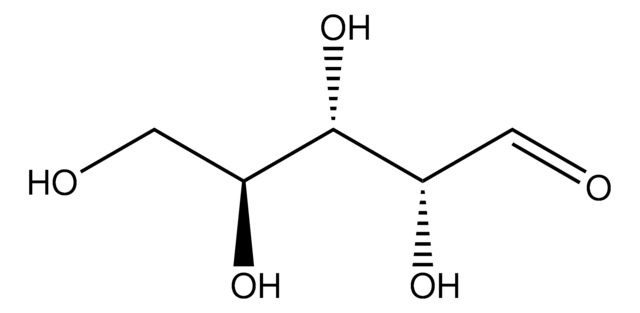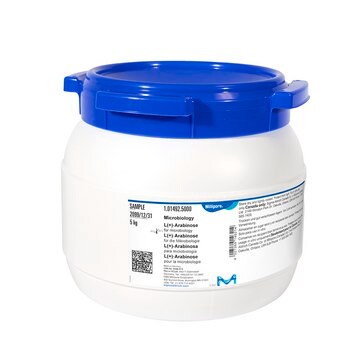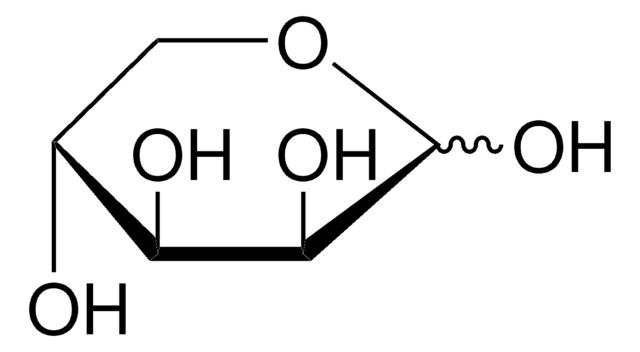A9524
DL-Arabinose
≥98% (GC)
Synonym(s):
(2R,3R,4R)-2,3,4,5-tetrahydroxypentanal
Sign Into View Organizational & Contract Pricing
All Photos(1)
About This Item
Empirical Formula (Hill Notation):
C5H10O5
CAS Number:
Molecular Weight:
150.13
Beilstein:
1723086
EC Number:
MDL number:
UNSPSC Code:
12352201
PubChem Substance ID:
NACRES:
NA.25
Recommended Products
biological source
cell culture
Quality Level
Assay
≥98% (GC)
form
powder
technique(s)
gas chromatography (GC): suitable
color
white to off-white
solubility
water: 50 mg/mL, clear, colorless
storage temp.
room temp
SMILES string
OC[C@H](O)[C@H](O)[C@@H](O)C=O
InChI
1S/C5H10O5/c6-1-3(8)5(10)4(9)2-7/h1,3-5,7-10H,2H2/t3-,4-,5+/m0/s1
InChI key
PYMYPHUHKUWMLA-VAYJURFESA-N
Looking for similar products? Visit Product Comparison Guide
Application
DL-Arabinose is a mixture of the diastereomers D-arabinose and L-arabinose used in physicochemical studies to measure properties such as dielectric relaxation. It may be used in chiral separation of sugars.
Other Notes
To gain a comprehensive understanding of our extensive range of Monosaccharides for your research, we encourage you to visit our Carbohydrates Category page.
Storage Class Code
11 - Combustible Solids
WGK
WGK 3
Flash Point(F)
Not applicable
Flash Point(C)
Not applicable
Personal Protective Equipment
dust mask type N95 (US), Eyeshields, Gloves
Choose from one of the most recent versions:
Already Own This Product?
Find documentation for the products that you have recently purchased in the Document Library.
Customers Also Viewed
Kamil Kaminski et al.
Carbohydrate research, 344(18), 2547-2553 (2009-10-28)
Dielectric relaxation measurements were performed on two enantiomers, D- and L-arabinose and their equimolar mixture, and compared to dielectric data obtained for D-ribose. D-Arabinose differs from d-ribose by having the opposite configuration at C2. This study reveals that both D-
Susanna L Heikkinen et al.
Carbohydrate polymers, 92(1), 733-740 (2012-12-12)
To increase understanding of the applicability of agro biomass by-products as biodegradable film formers, the effect of wheat arabinoxylan (WAX) fine structure on film properties was studied by applying specific enzyme modifications. WAX was selectively modified to mimic the natural
Karen L Visick et al.
Applied and environmental microbiology, 79(6), 2069-2080 (2013-01-22)
Biofilms are multicellular communities of bacteria attached to a surface and embedded in a protective matrix. In many cases, the signals that induce biofilm formation are unknown. Here, we report that biofilm formation by the marine bacterium Vibrio fischeri can
Silvia Herold et al.
Eukaryotic cell, 12(3), 390-398 (2013-01-08)
The ascomycete Trichoderma reesei is a paradigm for the regulation and production of plant cell wall-degrading enzymes, including xylanases. Four xylanases, including XYN1 and XYN2 of glycosyl hydrolase family 11 (GH11), the GH10 XYN3, and the GH30 XYN4, were already
Akiyoshi Ikeda-Boku et al.
Journal of biochemistry, 153(3), 317-326 (2013-01-15)
We developed an efficient method for introduction of 3-azidotyrosine (N(3)-Y) into proteins in Escherichia coli cells. We constructed a plasmid that is adaptable for the constitutive expression of both Methanosarcina acetivorans tyrosyl-tRNA synthetase (TyrRS) and tRNA(()(CUA)), and made an orthogonal
Our team of scientists has experience in all areas of research including Life Science, Material Science, Chemical Synthesis, Chromatography, Analytical and many others.
Contact Technical Service









